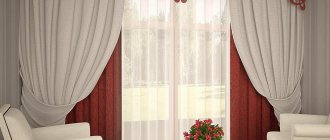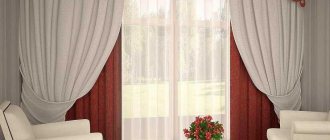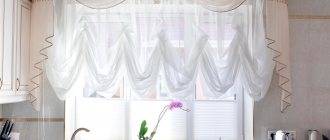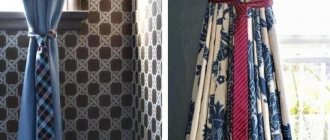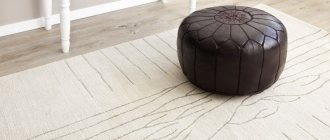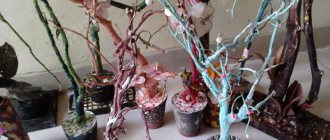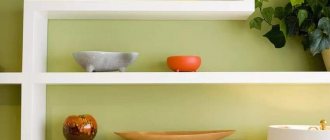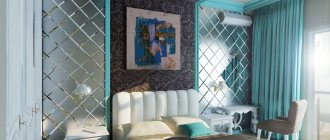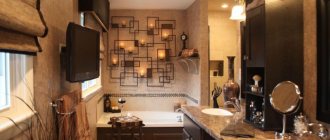What is a rigid bandeau lambrequin: getting to know the look
A lambrequin is a small strip of fabric that should be attached to a curtain rod. Basically, lambrequins were used to disguise a fragment of a wall that did not fit into the interior of the room.
Bando lambrequins of rectangular shapes can visually increase the height of the room
Nowadays, lambrequins most often serve as decorative decorations, giving the curtains harmony and sophistication.
Lambrequins are actively used in such a design style as modern. This style is relatively young and new, so lambrequins can be found in any design.
As for the rigid gang lambrequins, this type looks quite beautiful and unusual, giving the room a cozy feel. Now this type of lambrequins is used quite often, especially for decorating bedrooms, living rooms or any other rooms.
The rigid base of the gang lambrequin allows you to achieve the integrity of the composition of the interior of the room and window
Bandeaus for curtains are gradually moving into traditional window design, as this type of lambrequins is used for any interior style.
The history of the bando
The product belongs to the type of lambrequin, which is created on a rigid basis. Bandeau curtains have been used since the 17th century. Only rich people with high social status could use this decorative element, since the material for creating a bandeau was very expensive. Even in modern times, many people associate the presence of such an element in the house with high cost and sophistication.
The individual shape of a gang lambrequin can create the illusion of a semicircular window
Hard lambrequin: features
The first such decorations appeared quite a long time ago - back in the Middle Ages. Then they were made of wood, and were intended to hide not very attractive cornices from the eyes. As time passed, rigid structures were replaced by fabric ones - elegant and light. Nowadays, the lambrequin is more of a decorative element, although at the same time it is used to cover the rod, to hide the distance between the curtains and the ceiling.
A rigid lambrequin also has a second name - bandeau. This is an element that is made on a solid base, using fabric, as well as various accessories. This type of decor is named after the material of the same name, which saw the light around the 27th century. The main fabric is glued to the gang, thanks to this “commonwealth” the lambrequin can keep its shape well.
To create the “correct” hard decor, one condition is necessary: choose the correct height of this product. It must be equal to 1/6 of the length of the main fabric. To combine with curtains, use the same fabric, or another, but carefully selected in texture and color. There are no restrictions on decorative elements: you can use fringe, lace, and various accessories.
Lambrequins, made from several materials at once, different in both texture and color, make it possible to obtain an unusual, interesting composition even when the main fabric is not too bright and monochromatic. Fringe and various decorative inserts will help create a unique ensemble.
The second option, which also applies to hard lambrequins, is a combined product: it combines dense decor with regular, soft fabric. However, if we talk about how to make a rigid lambrequin with your own hands for the first time, then immediately comprehending the art of creating combined models is quite difficult. Without experience, it is unlikely that you will be able to achieve the ideal on the first try.
Bandeau for curtains: basic concepts
Bando refers to a non-woven glued type of material, which is the main component in the manufacture of lambrequins. If we turn to some sources, the gang lambrequin is often called Shabrak. This is due to the fact that it was the plant with that name that began production with this decorative element.
Bandeau lambrequins can perfectly match the style of the ceiling
Let's talk about the types of density of the bandeau for curtains, that is, 2 types: exposure using high temperature (hot-melt adhesive base) and fixing the bandeau after removing the protective coating (self-adhesive film).
The first type can be attached to the curtain using a regular iron with a steam function. The second type can be supplemented with some details (for example, foam rubber), this will help to properly secure the material.
Lambrequins, echoing the curtain motif, can visually divide a room with several windows
Often, bandeau curtains may have some additional elements and materials, for example:
- Brushes;
- Shuttlecocks;
- Cutouts;
- Patterns.
Where will a rigid lambrequin made of two fabrics look?
The window decoration fabric can be either one or several. A very convenient option if the thick curtain material is double-sided. Then the bandeau can be grouped as if from two fabrics - front and back. Under this condition, the main curtains can be re-hanged, depending on your mood. The lambrequin will look good on both sides. The picture is the same if the curtains were originally made from two fabrics, that is, with a lining.
If there are wide windows, people often hang not two, but multiples of two, panels. This combination allows you to choose different fabrics that match in texture, but are different in color, which are used to make a rigid lambrequin.
Thanks to their two-fabric base, the color and texture of such curtains can be changed depending on current preferences
The convenience of this type of lambrequin is the ability to close the curtains, the presence of a Velcro strip will allow you to remove it at any time for cleaning, you can make several lambrequins for different curtains with your own hands and change them depending on the time of year and the lighting of the house.
Curtains with bandeau for the hall
Basically, bandeau curtains are used to decorate the hall, since this room is the most visited among guests and should look modern, but at the same time cozy.
Bandeau lambrequins with curtains on grommets will fit original into any interior
Bandeau for curtains is indeed most often used for the interior of the living room, this is confirmed by various original interior ideas using this element.
Despite the fact that many consider the bandeau lambrequin to be a rather difficult item in terms of cleaning and care, this is not at all the case. This decorative element can also be created at home if you want some originality or simply don’t have enough money for such decorations.
The size of the gang with lambrequins affects the visual parameters of the window. For example, if the windows are large and wide, then a bandeau for curtains can significantly embellish the visual perception. If the window is narrow in size, you can attach a wide type of cornice above the window frame and complement this with a curtain band.
swag
swag
Information for web masters: COPYING ARTICLES, MASTER CLASSES FROM THE SITE LAMBRECEN.RU IS PROHIBITED IN FULL!!! See page: COPYING CONDITIONS.
In a white asymmetrical throw, I overcast the top edge and finish the bottom edge with bias tape. I hang it on a block under an equilateral green swag in such a way that the lower fold of the equilateral swag is wrapped in the upper fold of the asymmetrical swag. Like this:
Types of gangs and their purpose
There are 2 types of bandeaus: horizontal and vertical. The first type, vertical, is used quite rarely, for example, to replace heavy curtains. But horizontal is common in interior use; lambrequins can be simple in design.
The most common option is a horizontal stripe. Such lambrequins are used if the window needs to be closed completely or only a certain part. It looks simple, but at the same time modern and stylish, without unnecessary details. Basically, this type is used to decorate small windows; a rigid lambrequin can be complemented with a light chiffon curtain or night curtains.
The bandeau lambrequin looks good both with and without additional decor.
A more complex option is a textured one with a lining, which is complemented by various finishing details. This option is used to decorate large living rooms and halls.
Both options can be used in the interior of many rooms, the main thing is to approach design planning correctly and use a moderate combination of materials and color shades.
Ideas in different styles
Bandeaus fit harmoniously into any interior style and maintain a balance between all the decorative elements of the room.
Classic
In the classic style, they use rigid lambrequins made of elegant and noble fabrics, with a well-thought-out design.
The photo shows a living room in a classic style and a rigid lambrequin for curtains, decorated with tassels.
Provence
Simplicity and ease. A lambrequin of a simplified shape, with discreet floral motifs, in combination with light curtains will look very gentle and add even more rustic chic to the interior.
Minimalism
In this style, lush draperies and an abundance of accessories and decor are not allowed. The laconic design of the gang should be in harmony with the overall appearance of a clearly planned space.
The photo shows a children's room in a minimalist style and a window with a white bandeau for curtains.
Country
For country, they choose simple and light products that carry the lyricism of rustic motifs and closeness to nature. Typically, lambrequins are used without excessive pomp and lots of frills.
East style
Rich fabrics such as silk, velvet or brocade would be especially appropriate here. The windows are decorated with bands with complex damask patterns and a large number of decorative additions, such as tassels or fringe.
Sea style
Blue and white striped textiles are a traditional way to decorate a room in this style. Thanks to this decor, the room is filled with a fresh sea breeze, an atmosphere of summer holidays and romantic trips.
Do-it-yourself bando: step-by-step instructions
Nowadays, homemade bando is becoming quite popular. This is the least expensive option in which you can invest all your skills and ideas.
To create a bandeau, it is best to choose dense and low-flowing types of fabrics. Velvet or satin is suitable for making such an accessory. As for color shades, you should turn to softer and warmer tones that are suitable for any type of interior. A bandeau should not look too bright and pretentious, it looks ridiculous.
Thanks to the insertion of additional parts into the bandeau lambrequin, you can go from plane to three-dimensional
You can make the details of the product itself bright, so the bandeau will look more advantageous.
When choosing a fabric, you should focus on a practical fabric, since the material will be subject to cleaning (for example, vacuuming).
We must not forget that the bandeau will need to be supplemented with curtains, which must match the texture of the product itself.
Bando lambrequins can give a rich look to even the most ordinary room
If this is your first experience in the field of sewing and cutting, then it is best to make the blank and the initial version of the pattern on plain paper or an unnecessary piece of wallpaper.
It is necessary to attach this segment to the cornice and measure the length and width of the future gang. Then, transfer all measured data to the base that will be used for manufacturing.
To decorate the base, you must use pre-prepared fabric. Preparing the fabric means preparing the material for sewing: soaking in warm water, drying and ironing, so that in the future there will be no troubles (shrinkage or deformation).
The fabric must be applied to a pre-prepared base and cut off (it is worth taking into account the allowances that will be used to process the edges).
A curtain composition can consist of one gang lambrequin without compromising the effectiveness of presentation
If the base consists of two adhesive sides, then you need to attach the finished fabric to the front part and iron it with an iron. The second side is fixed to the cornice. This is a ready-made type of bandeau in the classic version.
If you would like to supplement the classic version with any additional materials, please do so. The design and appearance of the gang depends only on the imagination and skills of the person. But do not forget that the bandeau is a durable thing. Therefore, the manufacture of such a product must be approached with the utmost seriousness and every effort must be made to make the interior of the room look stylish and modern.
How to make a hard lambrequin with your own hands
The simplest option, the production of which does not require the help of the stronger half of humanity, is bandeau decor. However, there are other base options: for example, thin plywood or the same plastic can become the frame for a lambrequin.
Hard lambrequin on a gang
The first stage is to cut out the product in full size, so first measure the window opening (the size of the cornice) and calculate the correct length of the lambrequin (1/6 of the length of the canvas). The upper part of the pattern is often a rectangle, the lower part is a figure of the shape preferred by the author of the future product. The decor may consist of several parts that partially overlap each other. Then they are made separately according to their own patterns, and connected (sewn) only at the last stage.
- The paper pattern is transferred to the bandeau and then cut out. In this case, allowances are not needed. The adhesive material is applied to the wrong side of the main fabric so that there is space for allowances on each side of the pattern: at least 20 mm in the upper part, 15 mm on the remaining sides.
- The workpieces are connected to each other with pins, then ironed on an ironing board until the materials firmly stick to each other. Then the semi-finished product is turned over and ironed from the front side.
- Make a lining layer. The paper pattern is laid on the lining fabric, traced and cut out. They fasten it with pins “face to face” of the main material, stitch it, leaving only the top edge untouched.
- The lambrequin is turned right side out and carefully ironed again. The fabric on top, left for allowances, is folded inward, a stitch is laid, departing from the top edge by 3-5 mm.
- To make the stitching look beautiful, contrasting threads are used for the seam. Another option is stitching combined with sewing on decorative braid or cord. The last operation is sewing (gluing) adhesive tape to the upper edge of the product, attaching its counterpart to the cornice.
A lambrequin with rounded elements requires making notches on the allowances before turning it right side out. The purpose of such actions is to eliminate tissue tension in problem areas. If a decorative element is sewn for the kitchen, then in any case both fabrics (main and lining) must be pre-washed and ironed. The reason is possible deformation, loss of shape due to periodic high humidity.
Solid element on plywood
Not always a rigid lambrequin made on a bando has sufficient hardness, so they often use a more reliable alternative - thin plywood, but not thicker than 2 mm. In this case, a furniture stapler is needed to secure the materials. To give the lambrequin more volume, thin foam rubber is glued to the front side of the plywood sheet. All additional decorative elements are sewn on before covering the rigid workpiece with fabric.
Often a real plywood frame is made for a lambrequin, which looks like a box with sides, a front wall, a back and a top bar. All parts are fastened with wood screws (galvanized). Buy plywood that is thick enough, otherwise the screws are useless. First, the frame is assembled, but the top cover bar is left unattached.
- After making the box, they move on to cutting out the fabric. For the frame, a rectangle is cut out: larger than the total length of the sidewalls and front part (by 15 mm). The width of the part is 50 mm greater than that of the front side.
- Move on to cutting out the padding polyester and lining. The insulation pad is made of the same dimensions. For the lining material, cut out a rectangle: shorter than the front part, 50 mm.
- The synthetic winterizer is glued to the outside of the frame and to the sides. Sew the main and lining parts together, then use a furniture stapler to fasten it along the lower edge of the plywood structure.
- They pull the front part onto the facade, fix it with a stapler, then do the same with the side elements. The box is turned over, the lining is placed inside, then secured with a stapler.
- For the top bar, an element is cut out with allowances of 15-20 mm. They shoot it in the center, in the corners, tuck it, then wrap it and fix the remaining sides.
- Hangers are attached to the backdrop, marks are made for them on the wall, fasteners are mounted, and a lambrequin is hung.
The finished product is decorated with additional draperies, shooting the gathered material with a stapler, or with fringe, cord or appliqué. In general, the scope for decoration in this case is limited only by dormant imagination.
Hard lambrequin with edging
This combined option is somewhat more complicated, but not so much that you can’t handle it yourself. Following the instructions will make the job much easier.
- First, a pattern is drawn, the same as for a regular decoration. Then it is transferred to the adhesive material. The borders where they plan to make the edging are marked on the bando. For subsequent alignment of elements, vertical marks are placed. Using the boundaries as a guide, parts of the base are cut out.
- The main fabric is glued onto them. Cut out the material for the edging: add 15 mm allowances on each side. On those sides where the fabrics will be connected, notches are made, but they are not brought to the bandeau layer - 3-4 mm are left. The resulting allowances are ironed to the wrong side.
- Cut out the main part of the lambrequin from the fabric: leave an allowance of 25 mm on top, 15 mm on the other sides. The edging is placed with the wrong side up, then the main part is also placed with the adhesive layer facing up. They are guided by previously set vertical marks, which must coincide.
- The elements are pinned together, then, stepping back from the edge of the edge a couple of millimeters, a stitch is laid that will connect the parts. The whole fabric is laid out on the lining fabric (front side to front side), then cleaved, cut along the contour, leaving a distance for allowances.
- Connect the lining fabric to the front fabric: step back 2-3 mm from the edge of the bandeau. The top of the lambrequin is not touched.
The product is turned right side out, ironed, and the top edge is processed, folding the edges inward. Decorate the cornice decoration at your own discretion.
Openwork solid lambrequin
The most convenient way is to use openwork appliqués. In this case, the main condition is the color of the fabric. It must contrast with the rigid base so that such a pattern is clearly visible during production. The choice of color of the material is not very important: it can be monochromatic, or have some kind of pattern, but not too bright.
- You can draw any ornament. Popular options are flowers, leaves or intertwined stems, a pattern found on any interior detail. The only requirement is moderation. First, the drawings are made on a regular sheet of paper. After their comprehensive assessment, the patterns are transferred to life-size paper.
- To connect individual elements into a whole picture, spider webs and non-woven fabric are used. The main fabric is connected to the interlining using an iron. An adhesive web is laid out on the inside, followed by a padding polyester lining, which is first quilted with a thin lining fabric.
- To create clear contours, you need to purchase (or borrow from someone) an electric burner. The pattern is redrawn on the wrong side of the resulting pie made of fabric and insulation. Burn the design with a well-heated tip of the device.
The finished patterns are placed on the base of the lambrequin and fixed with hot glue (glue gun). Decorate the decorative element with sparkles, rhinestones, or additional draperies.
Bando lambrequin (photo)
What are soft lambrequins
Not everyone has the skills to work with wood and therefore many prefer soft lambrequins. This type of window opening decoration is beautiful and elegant, but requires an additional line of curtains. When the curtains move daily, the lambrequin should remain motionless. During the monarchy, lambrequins were most often used to frame a bed, but even now a common design move in the bedroom is identical lambrequins above the window and above the bed.
It would be more appropriate to hang this type of decoration in the nursery - for girls it will be the room of a princess from a fairy tale, and for boys you can choose a sea or space theme. The main fabric of the curtains must be secured to the wall with cords, since during games the panels can serve as anything but curtains. And this leads to rapid wear and tear and danger, since a fallen curtain will not bring anything good.
Lambrequins will look great in a children's room
A soft lambrequin can be made from one or more fabrics, and consists of stripes (the simplest type), swags and crossovers.
Craftswomen make soft creases or draperies with their own hands. But this is not the easiest thing, since patterns for decoration are more complex and require skills in working with a sewing machine and the ability to cut.
Lambrequin on a solid base
If the density of a solid lambrequin is not enough, then as a base you can choose not adhesive material, but thin plywood with a thickness of no more than 2 mm.
In this case, all actions to cover the base with material will be performed using a construction stapler. At the same time, during production you can also use various fabrics and decorations, which are stitched and sewn to the base material before covering the plywood with it. And in order for the rigid lambrequin to look more voluminous, thin foam rubber must be glued to that part of the plywood blank that will serve as the basis for the front curtain fabric.
Having carefully studied these instructions, the question of how to sew a rigid lambrequin will no longer arise. And every housewife who has at least a little experience in cutting and sewing can quickly do it on her own, paying sufficient attention to the clarity and accuracy of edge processing to achieve a high-quality result. At the same time, she will receive maximum pleasure from the work done and will complement the interior of the premises in her home and the beautiful curtains themselves with an exclusive decorative element. Lambrequins are divided into three types. There are hard, combined and soft types of products.
For the greatest completeness of the interior, it is advisable to sew a hard lambrequin yourself. Before you start sewing a lambrequin, you need to measure the window opening to determine the size of the future product. A rigid lambrequin, decorated with flowers, in combination with even simple curtains will be a worthy decoration for the bedroom. For the lambrequin, you should provide the usual length, which will be one sixth of the total length of the curtain . The window openings will be designed impeccably.
